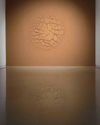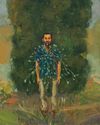
In his most recent works exhibited at Nature Morte’s virtual viewing room from the 11th of August to the 31st of December, Jitish Kallat continues his long-standing artistic preoccupation of exploring the meaning of time and its effect on the transformation of bodies.
Kallat’s attention was held by the shadow constellations of twigs that had fallen in his studio, the changing outlines of which are woven into the rhythms of a new biological universe. Circadian Studies draws several associations together making us dwell upon the cycles of experience and existence; it makes us rethink the modes of corporeal and cosmological inhabitation.
The close observation of shifting shadows has been a civilizational preoccupation. In the 16th century Europe, Galileo made accurate renderings of shadows he observed on the surface of the moon through his telescope to postulate the centrality of the sun within the solar system. Around the same time in the Middle East, sundials were embedded within the architectures of several mosques so that prayers could be attuned to cosmic alignments. Such obsessions for finding higher meaning have left us with fantastic instruments like astrolabes that inscribe us in the geometry of a proximate galaxy, and at the same time, monumental observatories that reflect astronomical cartographies of the visible sky on earth. In India, the time-devices of Jantar Mantar, fantastically designed to counter the delineation of shadows, bring to us the most subtle yet phenomenal sensation – those that confirm the sublime duality of the fact that the planet that holds us all still, is indeed moving.
هذه القصة مأخوذة من طبعة December 2020 من Art India.
ابدأ النسخة التجريبية المجانية من Magzter GOLD لمدة 7 أيام للوصول إلى آلاف القصص المتميزة المنسقة وأكثر من 9,000 مجلة وصحيفة.
بالفعل مشترك ? تسجيل الدخول
هذه القصة مأخوذة من طبعة December 2020 من Art India.
ابدأ النسخة التجريبية المجانية من Magzter GOLD لمدة 7 أيام للوصول إلى آلاف القصص المتميزة المنسقة وأكثر من 9,000 مجلة وصحيفة.
بالفعل مشترك? تسجيل الدخول

Parts, Wholes And The Spaces In Between
Sonal Sundararajan introduces Samira Rathod's free-spirited and rebellious explorations in the world of architecture, furniture and design.

"The Fine Art of Going to the Pictures."
Dr. Banerjee in Dr. Kulkarni's Nursing Home at Chemould Prescott Road brings together 26 paintings featuring a series of dramatic scenes from Hindi and Bengali films. In conversation with Abhay Sardesai, artist Atul Dodiya talks about childhood trips to movie halls, painted figures gripped by tension, and the closeness and remoteness of cinematic images.

"To Finally Have Something of Your Own to Mine."
Dayanita Singh is the recipient of the coveted 2022 Hasselblad Award. Keeping the photograph at the centre, she speaks to Shreevatsa Nevatia about books, book objects, photo novels, exhibitions and museums.

OF DIVINE LOSS
Shaurya Kumar explores the relationship between the subject and object of devotion, finds Aranya.

THE PAST AND ITS SHADOWS
Neha Mitra visits two shows and three artists in Mumbai.

FORCE OF NATURE
Alwar Balasubramaniam dwells on absences and ephemeralities in his new work, states Meera Menezes.

SHAPES OF WATER
Devika Sundar's works delineate the murky, malleable boundaries between the human body and the organic world, says Joshua Muyiwa.

INTIMATIONS OF INTIMACY
Sunil Gupta shares his journey with Gautami Reddy.

THE FRACTURED PROSPECT
Nocturnal landscapes as ruins in the making? Adwait Singh looks at Biraaj Dodiya's scenes of loss.

TEETERING BEYOND OUR GRASP
Meera Menezes traces Mahesh Baliga's journey from Moodabidri to London.